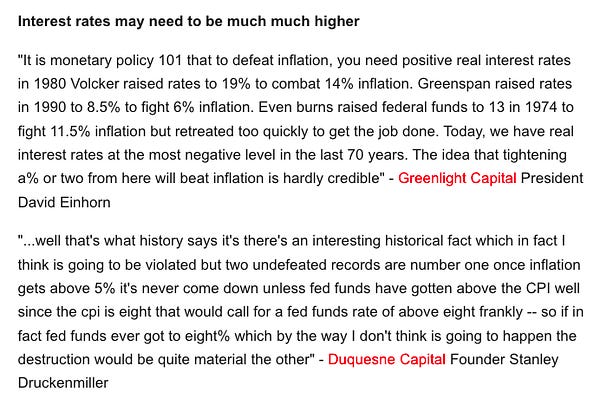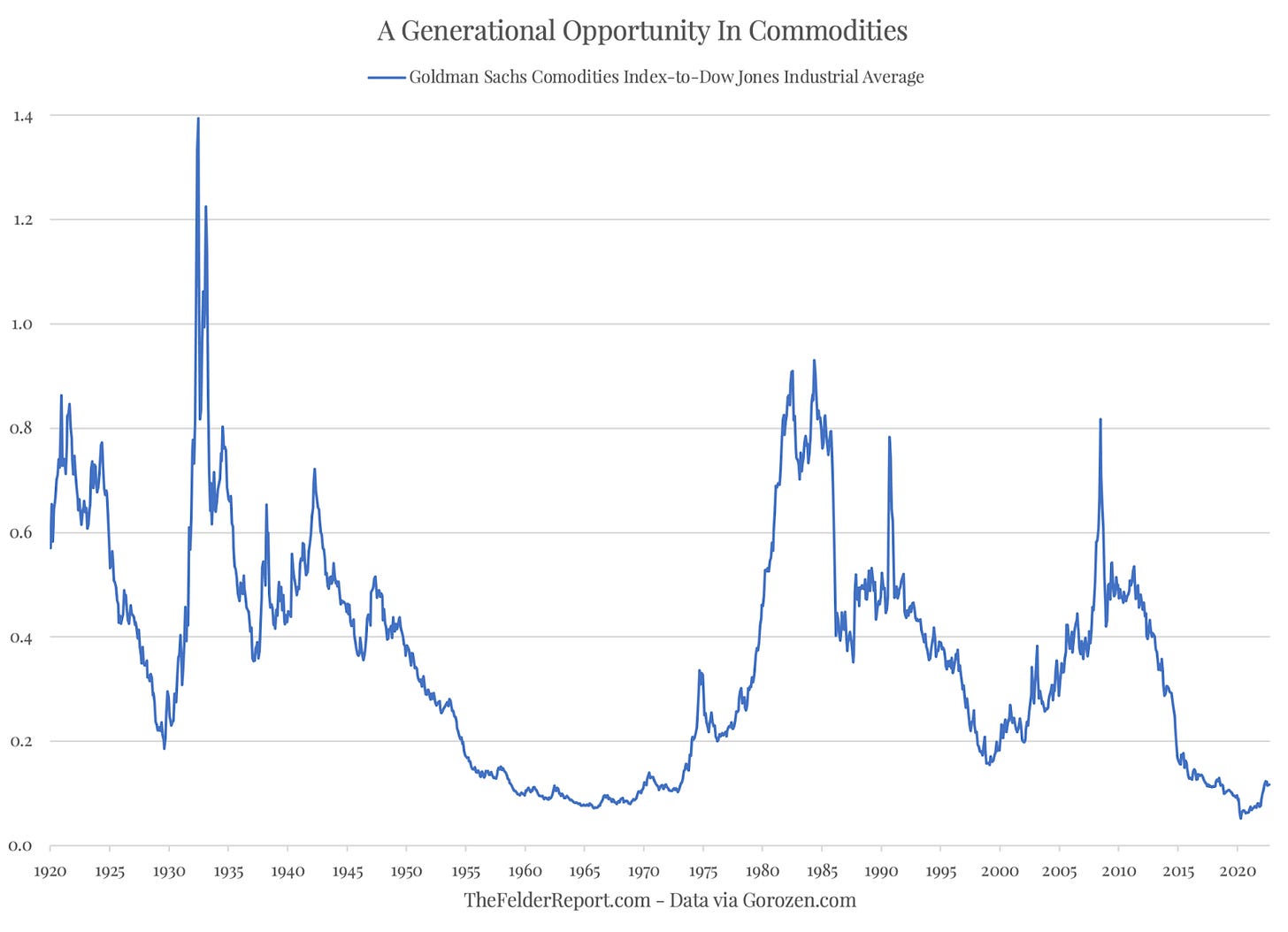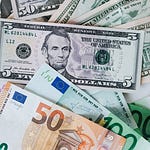In this special episode, we are joined by Jesse Felder of The Felder Report to discuss the macro takeaways from our recent newsletters. We discuss the Fed's fight with inflation, the heightened recession risks, the distress in financial markets, and the early innings of a commodity supercycle.
A transcript of this podcast, with relevant images and quotes, is available for all subscribers just below the show notes. The episode is based on our recent newsletters, including yesterday's, which are available on Substack.
Our podcast is also available on Apple Podcasts, Spotify, Google Podcasts, YouTube, and Amazon Music.
Show Notes
00:00:00 Introduction
00:00:15 The Fed’s Hard Time with Inflation
00:02:46 Inflation Is a Choice
00:06:54 Recession Risks
00:10:36 When will Real Rates be Positive?
00:12:47 Declining Consumer Deposits
00:15:50 The Energy Crisis & The Commodity Supercycle
00:22:54 Conclusion
Transcript
Introduction
[00:00:00] Scott: Welcome everybody to a new episode of The Transcript podcast. We've got a special episode today, a special guest joining us, Jesse Felder, who's a well-known macro analyst and author of The Felder Report. You've also got me, Scott Krisiloff, editor of The Transcript, and Erick Mokaya, who's our lead author.
The Fed’s Hard Time with Inflation
We sent out a new issue of the newsletter yesterday and what we saw was that the Fed is still trying to break the back of inflation, but having a hard time doing so. And the main reason that it's having a hard time doing that is just because the economy is actually holding up pretty well. The consumer remains resilient and continues to spend and that is keeping inflationary pressure on the economy. So the Fed is going to try to, honestly, it seems like they're trying to engineer recession at this point. But more pain may be coming according to Jamie Dimon. Jesse, any thoughts on anything you're seeing these days?
"The environment clearly is still very inflationary with a lot of supply chain challenges across the industry and everybody trying to have responsible behaviors to maximize the value of its brands." - PepsiCo (PEP 0.00%↑) CEO Ramon Laguarta
“Inflation is a bit like toothpaste. Once you get it out of the tube, it’s hard to get it back in. The Fed is furiously trying to wash that taste out of their mouth -- If we go into recession, that has really negative consequences for a variety of assets." - Hedge Fund Manager Paul Tudor Jones
[00:00:50] Jesse: I think there's not been enough talk about how far behind the curve the Fed is. And I think you guys have highlighted on Twitter that historically the Fed funds rate needs to go positive in real terms before inflation can really be addressed. And with headline inflation still running north of 8% and Fed funds sitting just above three, there's still a massive gap there because the Fed funds rate is still deeply negative and so I think that monetary policy is still technically, very dovish and that might be the main problem.


[00:01:21] Mokaya: Yeah, for me, from the bank earnings last week, the key takeaway of course is that whatever the Fed is trying to do, the economy is not feeling it yet. Because I think most banks are just saying that the consumer continues to spend really a lot. I don't know if that is in trying to keep up with the rising inflation rate. But as you say, like Scott, I think the key takeaways from Bank of America CEO who says consumer spending which is strong, is actually the Fed's biggest challenge. And some takeaways maybe also from the FOMC last week, in the minutes they said they need the unemployment rate to rise even as they try to contain inflation. So I don't know what your takeaways are from that because usually a low unemployment rate is good, but it seems like the Fed is saying okay, this is actually a problem at this point in time.
[00:02:09] Scott: Yeah, I think the Fed is actively telling us very explicitly that they're trying to pull demand back and that they're okay with a rising unemployment rate. And both of those things sound a lot to me like a recession. And so it's very interesting. Jesse, you make a really good point that they're actually still dovishly positioned, because of where interest rates are relative to inflation. My question, Jesse, actually, do you think that they'll ever get to a really hawkish stance? Like where do you think the balance will end up being with inflation and interest rates, if you had to guess, or what's your working assumption right now?
Inflation Is a Choice
[00:02:46] Jesse: I think that probably what markets and most investors are missing today is inflation is a choice. Inflation is a policy. When debt levels get to over 100% of GDP, which we're at today, 120 plus I think, here in the US, it's just government debt. The obvious way to deal with that is inflation, and I think that in the midst of in the early days of the pandemic, when the Fed explicitly changed its inflation targeting framework from basically a 2% ceiling to a 2% average, I think that was a very clear message to the world that we want inflation. And so I think it's clear that the Fed wants inflation, needs inflation. The Federal Government absolutely needs inflation to deal with the amount of debt that's out there, but they don't want it to run out of control. And so J Powell has to pretend to be the second coming of Paul Volker, even though that's impossible. Debt to GDP under Paul Volker was 30%, it's four times higher today. So he literally can't raise rates to 20% like Volker without bankrupting the government and without creating a debt spiral. But he has to pretend that the Fed is going to do this in order to prevent inflation from really going out of control. That's why they're watching inflation expectations and these things so carefully because if you do get an inflationary mindset, you could start getting what some Austrian economists have called a crack-up boom, which is people start thinking, wait a second, inflation's never coming back down again. I need to start buying, hoarding things and you get this inflationary mindset, which creates an even bigger inflation problem. So I think that the Fed's trying to prevent that, but they're not willing to do whatever it takes to bring inflation back down below 2.
[00:04:32] Scott: Yeah it's interesting as you're talking, I'm thinking about the gap between two things. One, the lag between the effective monetary policy and the real economy. And we're seeing right now the Fed with rhetoric that's extremely hawkish and policy that's trending towards hawkishness. 75 basis point raise increases are pretty extreme. And the economy is not yet keeping up with that. So you would expect the economy and monetary policy to start to come back into alignment in a way that would be negative for the economy. But then there's another layer on top of this that you're bringing up, which I'm interested in teasing out more, which is the extent to which the rhetoric is more hawkish than the actual policy, and the rhetoric is more hawkish than they intend the policy to ever get because the Fed may be backed into the corner. What's your own estimation of the rhetoric versus the policy and when the rhetoric can start to be dovish again or can it.
[00:05:31] Jesse: Yeah, we've already heard it, right? J Powell had to walk back. Some of the things he said at recent Fed meetings. I think, look if J Powell were the second coming of Paul Volker, he would say, inflation's here, Fed Funds need to be here. You look at things like the Taylor Rule that says Fed funds should be 9% or something insane. But even, the Fed is acknowledged, right? We think Fed policy should be about 4.5% is where we're trying to get to. Why didn't they just put it there? Why don't they just go, okay, we've been at zero, why don't we just go to four and a half if that's where policy should be? Because it would crash the markets and create all kinds of problems. And potentially debt problems, right? We're seeing serious liquidity problems in the treasury market already, Fed funds is 3% and they've only started quantitative tightening. And so there's all these reasons why they can't implement the policy they really, feel like they probably should. And so I think that's why they haven't been, as hawkish as they need to be. And it's also why we hear talk about, okay, at some point we're going to need to slow the pace of rate hikes and at some point it's gonna be appropriate to pause and see how they affect the economy. And of course, pausing at four and a half, right? When we see headlines, CPI is still seven, six and a half. You still don't have a real Fed funds rate. So I still see that as dovish, personally.
Recession Risks
[00:06:54] Mokaya: Yeah. A quick question Scott in the Fed's push towards dealing with inflation, I think some of the comments that you read from JP Morgan's CEO, Jamie Dimon, is about how this is very serious in the sense of the bid to deal with the inflation, the Fed is actually going to create a recession. And the second thing he said is, there's more downside to go for equity markets. And I think, Scott, you've been clear on this, and from reading Jesse also I've seen the same. So from where we are now, what's the likelihood that actually we are in a recession and what's the likelihood that the markets actually have more downsides to go from where we are?
“These are very, very serious things which I think are likely to push the U.S. and the world — I mean, Europe is already in recession — and they’re likely to put the U.S. in some kind of recession six to nine months from now. From here we let’s all wish him success and keep our fingers crossed that they managed to slow down the economy enough so that whatever it is, is mild — and it is possible" - JPMorgan Chase (JPM 0.00%↑) CEO Jamie Dimon
“More than a third of the global economy will contract this year or next, while the three largest economies—the United States, the European Union, and China—will continue to stall. In short, the worst is yet to come, and for many people, 2023 will feel like a recession" - IMF
[00:07:30] Scott: I think this is what I was talking about in terms of the lag between the economy and monetary policy is that we're not in a recession yet. But we are very clearly on the way to a recession based on where monetary policy is and the effect that the Fed is trying to have on the economy. They are trying to slow it, and they are okay with a rising unemployment rate. They are okay with falling equity prices. And so the Fed, I believe, is ultimately going to get their way. They usually do. And so you have to expect that a recession is likely to come.
[00:08:03] Jesse: There are two macro indicators that I watch really closely. The first one is insider buying and selling. I use it as a micro analysis kind of a thing where I'm looking for insiders that have a good track record of buying their own stock. And that's for me as a value investor helps confirm my idea of a value when I find what I think is a cheap stock. But when you aggregate it, it can be very valuable too. Nejat Seyhun, who at the University of Michigan has done a wonderful amount of quantitative analysis on insider trading, and it's fascinating to see in aggregate when you just look at executives and directors, not 10% owners, but really, people who are closely involved with the company and you just look at their insider buying and selling when you see the sell to buy ratio go very high, that's a really good indicator of not just returns in the stock market 12 months out, but also what the economy does 12 months later. And I've actually taken this and then taken the insider cell to buy ratio and overlayed it with a 12-month lag over ISM and you can see insider activity is a very good predictor of economic activity, as indicated by the ISM and things like that. So we saw insider selling last year, just literally off the charts. It went over 30 times on a 12-month average basis, which is a massive amount of insider selling. I don't think we've ever seen that much before. And that suggests that over a 12 to 24-month period we're going to see the economic slowing and that suggests probably that the peak in that ratio suggests that the bottom for the economic kind of recession should be around the third quarter of next year. At the same time, when you put together the rate of change, 12 month rate of change in the dollar interest rates and oil prices, when all three of those things are surging, it almost always has a really good two-year lead over the earnings growth, S&P 500 earnings growth, and so that has been surging, obviously, right? We've seen the oil price go from negative to over a hundred dollars a barrel, seen interest rates go from 50 basis points on the ten-year to four, up tenfold, essentially on the ten-year treasury yield and then the dollar obviously has been super strong. So the three of those things are a really good, two-year lead on S&P 500 earnings growth. That also suggests that we're gonna see a pretty deep earnings recession next year. That's not yet priced into the stock market. So that's something to be concerned with as well. So I do think it's clear we're probably headed to recession and it's gonna impact earnings in a significant way.
When will Real Rates be Positive?
[00:10:36] Scott: And I think to your point earlier, Jesse, about where interest rates probably should be in order to be a real positive interest rate. If you're thinking about it, just the cost of capital that's implied, the cost of equity that is implied on those interest rates, mortgages at 7% mortgage rate today, you would expect the S&P 500 earnings yield to at least be there, if not higher than the mortgage rate. And right now, at peak earnings, we're at like about 18 times peak earnings, which is just not congruent with what the cost of capital needs to be and where it's going. And especially as earnings come down likely in a recession, there's real significant potential downside for equity prices here that's still not priced into the market. And that has its own follow-on effect, basically on inflation and financial stability and all of these things and creating more recession. So that's why we titled the newsletter this week Stormy Weather because it looks like we're headed for that.
[00:11:38] Jesse: Yeah you and I think the only point that I would add to that is that you talk about 18 times, peak earnings. But I think you also need to look at what are the profit margins underlying those earnings. Margins are literally off the chart, record profit margins. A lot of that has come from the unprecedented fiscal stimulus in the last couple of years, has boosted profit margins and businesses have been able to raise prices faster than wages. That's probably reversing now where wage growth is finally catching up and their ability to raise prices is starting to hit a wall. And so that is probably what's going to make for that earning recession. I'd also just point out too that while the macro and the fundamentals still look very bearish for the next, 12 months or so, tactically, over the last couple of weeks, there have been a lot of signs that stocks are oversold, sentiment has become too bearish and that momentum has started to wane in terms of the stock prices and things. I think the difficult part in actually implementing these types of ideas is that when the tactical suggests it's probably time to be bullish but the macro and fundamentals are saying things are still really bearish, it creates a pretty clouded picture.
Declining Consumer Deposits
"...with spending growing faster than income, we are seeing a continued decrease in median deposits year-on-year, particularly in the lower income segment." - JPMorgan Chase (JPM 0.00%↑) CFO Jeremy Barnum
"We've seen average balances steadily decline and are now below pre-pandemic levels, and their debit card spend continues to decline." - Wells Fargo (WFC 0.00%↑) CEO Charles Scharf
"...consumer deposits declined $4.3 billion or 2%, reflecting inflationary pressures and seasonally higher spending." - PNC Financial Services (PNC 0.00%↑) CFO Robert Reilly
[00:12:47] Mokaya: Maybe another observation from this week also is about the consumer deposits declining. I think it's quite significant that for a long while, one of the things that has been driving the spending is of course, that consumers have a lot of cash in their accounts. But then some of the banks that reported last week are saying consumers' deposits are actually declining. So I think that it was PNC that talked about it a 2% decline. It's minimal, but it's significant that instead of going up, like it has the past couple of quarters, now it's actually declining. One of the forecasts that I saw is that they may run out of this, especially what they've put up these past two years, they may run out of it by next year given the high inflation rates that you are having also. I don’t know if you have any comments on that. And also on the fact that there are pockets of the market now that we are also seeing signs of distress. There are a couple of quotes also on the same, especially the UK markets in the past month or so. Sign of distress in the market. And I think one of the executives also talked about banks finding it hard to intermediate in particular areas of the market when the Fed now has had to step in a little to do a bit of the buying again. Do you have any thoughts on these areas?
[00:13:53] Jesse: Absolutely. I think, in terms of the consumer I mean they, we mailed checks out and we saw cash balances go up dramatically. But also I think what was potentially an underrated part of that was a lot of it was used to pay down debt, pay down credit cards and these types of things. And so we see those cash balances going down. But then, as you guys have pointed out, a lot of the banks are saying that consumers are still healthy in terms of their cash balances, but in terms of also the credit available to them on credit cards and things is still significant. And so you're really not seeing that crimping on the consumer side, that would be a clearer sign that you're heading into a recession. And it's also troubling to the Fed that there's still plenty of spending power there at the consumer level at the same time that wages are rising dramatically. So yeah it's an interesting situation in terms of that consumer health.
[00:14:48] Mokaya: Scott, any thoughts?
[00:14:49] Scott: Yeah, I think there were elements in terms of the consumer health that we picked up as well, about the bifurcation or difference between the higher income consumer and the lower income consumer. And I think that on that deposit side, the excess deposits were especially for the lower income consumer savings would be predominantly in some sort of deposit account rather than likely in capital markets and equities, things like that. It's just another indication that as the tide kind of pulls back in the economy the first area of the economy that starts to get hit is the lower-income consumer. And so, not only the fact that deposits are falling but also the fact that JP Morgan pinned when it would expect the excess deposits to start to run out in terms of mid-next year. That's a really important data point to be looking for because that would probably coincide with the peak of the recession would be like mid-next year. You can start to think about it. So all important data points, I think from that perspective.
The Energy Crisis & The Commodity Super Cycle
[00:15:50] Mokaya: Yeah, maybe quick thoughts also on Europe's energy crisis and the commodity cycles. I think Jesse you’ve written something about the commodity supercycle that you're expecting. I'm based in Europe, so I can already see in the energy bills how they're skyrocketing. I think in the UK I saw a quote where one of the companies was trying to set up a hotel and they got a contract. The energy bill is 10x up from around 800,000 pounds. I think the energy distress in Europe is quite significant, and one of the quotes we picked up is some companies are actually considering shifting their operations base from Europe to the US to take advantage of the lower energy costs over there. Any thoughts on these? And how perhaps the current macro environment plays into the commodity Supercycle.
[00:16:33] Jesse: I think it's a tragic situation in Europe and I have a great deal of sympathy for the strains that people are going under there. But just from a pure investment standpoint, I do think we're only in the very early innings of a larger commodity supercycle. I think that when you look at the valuation of commodities relative to financial assets, relative to stocks, bonds, these types of things, commodities are still dramatically undervalued. And at the same time we've had this, if you just look at the capital cycle we've had in the last 5, 7, 10 years, massive investment into technology and these types of things. And that's continuing. We're seeing huge investment in the semiconductor industry right now in China and in the United States, and even more broadly in cloud and these types of things. At the same time, since the oil price crashed in 2014, we've seen a huge drop off in capital investment in commodities and basically returns follow capital. So when you see a lot of capital invested in the sector, returns necessarily go down for years afterwards. I think that's probably gonna be the case for technology broadly. And I think because of the massive underinvestment in commodities in the last five to seven years there's going to be supply constraints that last a long period of time. I think in a lot of ways, what we're looking at right now in terms of where the Fed is, where inflation is, where commodity is, it's very similar to the early to mid-seventies. I think that's in terms of where we are in the commodity cycle. We're in early innings in the larger commodity boom. Technically, in that post that I put up too, you'd see the Bloomberg Spot Commodities Index just broke out to a new high this year. That, just as a technical signal, long-term signal has been a very good indicator that we've been in a long-term range, maybe 10 years for commodities. When you break out of that range to the upside, it's just a very clear technical signal. Something changed. And I think that's a clear technical sign too, that prices are entering a new long-term uptrend.
[00:18:39] Scott: I think one thought based on what you were saying, Erick, about companies looking at coming to the US to produce based on the energy problems in Europe. I think that actually speaks to the magnitude of the energy crisis in Europe that people are thinking in that way because actually, with the dollar being strong and the Euro and the Pound being weak, you would actually expect the dynamic to be happening in the exact opposite way. You would expect for the currency to be benefiting industrial producers in foreign territories. And so that actually speaks to the real dislocation that's been caused by Russia's action in Ukraine and the access to energy in Europe that really could have a multi-year or longer impact on the European economy if there aren't other forms of energy that are secured or other sources or something changes, something flips. I think we've been really a bit bearish on this call today. Obviously, there are several things that could flip war in Ukraine and Russia could flip. And there could be somehow out of that more access to energy for the world in Europe. And then, Fed psychology, especially if we think that it's rhetoric that's pushing this and being backed into a corner, at some point I'd expect the Fed is still not able to handle the pain of lower equity prices and recession. So they may flip more easily. But those are the sorts of things that I'm really looking for as catalysts that would swing this back in a positive direction. Short of that, it looks like we're in for a bumpy ride here.
[00:20:17] Mokaya: And speaking as someone based in Europe, what I can tell is that the energy crisis is really real and people are feeling it. People are very scared, especially on how energy bills are going to be this winter. The people who are benefiting right now are those who had a bit of a fixed contract with the energy companies, but if you had a flexible one this is going to be a tough one. That's first. And then second, what you're seeing, the new government, especially in Sweden, is also thinking of investing heavily in nuclear power. Any commodities that feed into nuclear energy and all alternative sources of energy, I think that's an area that most of the governments around Europe are looking very keenly for the next five to 10 years.
And, some of these projects are actually long-term, so when they say, they really want to invest in this, it means that for the next five to 10 years, this is where you're going to see a lot of the capital flowing. Just as Jesse said, there’s been underinvesting. I think there’s a couple of quotes we've been picking the last four or five weeks that a lot of CEOs in the energy sector are saying we've heavily underinvested in energy and it's time that we scale up that investment. So you're going to see a lot of capital flowing from the government and from the private sector flowing towards these areas. I think that would be maybe a good place to close. Any closing thoughts from Jesse and Scott?
[00:21:31] Jesse: I think it's bearish for what worked well over the last 10 years, it's bearish for, but I think it's extremely bullish and this is how bull markets work, is that the leaders coming in a new bull market are usually not the same companies that led in the previous bull market. And so I think it's extremely bullish. And the only other point that I would make is that a lot of what we're talking about is dancing around this, the subject of de-globalization. I think when you look at what really made the last 10, 20, 30, 40 years possible, it was falling inflation and falling cost of capital for businesses and all these kinds of things. And a lot of that was part made possible by falling energy prices in real terms, improving demographics and globalization. And I think it's very clear that globalization has shifted in a serious way that it is no longer disinflationary. And also that demographics are shifting in a way with the aging of societies. The Great Demographic Reversal is a wonderful book by Goodhart and Pradhan, that I think is must read for investors today. It talks about how these huge macro shifts are underway from a disinflationary to an inflationary regime. And so I think it is, yes, it's bearish for maybe the things that, like I said, worked well in the last 10 years. It's extremely bullish for a new way of looking at markets and looking at things that do well in an inflationary environment.
Conclusion
[00:22:54] Mokaya: Okay. Scott, closing thoughts?
[00:22:57] Scott: I think that was a great place to close.
[00:23:00] Mokaya: All right. Thank you so much, Jesse, for joining us this week. We hope to have you again sometime soon to discuss more macro. And Scott, always thank you for being here with us. You can always follow Jesse on Twitter. He's very active there. And also you can check out his newsletter. Is it weekly or?
[00:23:17] Jesse: Yeah, it's pretty much like a blog post on Wednesday and I send out a free email where I highlight some of the things I'm reading and I just wanna say too, this has been a blast, but I really appreciate what you guys do and putting together just synthesizing a wonderful amount of data. That's basically what I spend most of my time doing, and you guys saved me a lot of time, so I appreciate reading The Transcript.
[00:23:39] Mokaya: So we are your outsourced analyst in short.
[00:23:42] Jesse: Absolutely. Yes, take full advantage.
[00:23:44] Mokaya: All right. Thank you so much. And I should say on Wednesday we have Twitter spaces and we'll be discussing bank earnings. So key takeaways from bank earnings. Scott and I will be joined by Marc Rubi from Net Interest, another really great analyst. Watch out, we’ll put a link in the podcast today so that you can be able to join on Wednesday after markets close. So thank you so much for this week. I'll see you again next week.


















Share this post